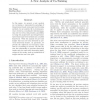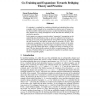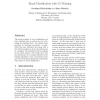119
Voted
IJSI
2008
15 years 20 days ago
2008
Many data mining applications have a large amount of data but labeling data is often difficult, expensive, or time consuming, as it requires human experts for annotation. Semi-supe...
79
Voted
ICML
2010
IEEE
15 years 1 months ago
2010
IEEE
In this paper, we present a new analysis on co-training, a representative paradigm of disagreement-based semi-supervised learning methods. In our analysis the co-training process ...
130
Voted
NIPS
2004
15 years 2 months ago
2004
Co-training is a method for combining labeled and unlabeled data when examples can be thought of as containing two distinct sets of features. It has had a number of practical succ...
98
Voted
CASCON
2001
15 years 2 months ago
2001
The main problems in text classification are lack of labeled data, as well as the cost of labeling the unlabeled data. We address these problems by exploring co-training - an algo...
110
Voted
ADCS
2004
15 years 2 months ago
2004
Co-training is a semi-supervised technique that allows classifiers to learn with fewer labelled documents by taking advantage of the more abundant unclassified documents. However, ...
87
Voted
NIPS
2007
15 years 2 months ago
2007
We propose a Bayesian undirected graphical model for co-training, or more generally for semi-supervised multi-view learning. This makes explicit the previously unstated assumption...
102
Voted
WEBI
2004
Springer
15 years 6 months ago
2004
Springer
When dealing with information overload from the Internet, such as the classification of Web pages and the filtering of email spam, a new technique called cotraining has been shown...
102
Voted
IJCNLP
2004
Springer
15 years 6 months ago
2004
Springer
This paper explores collaborative ability of co-training algorithm. We propose a new measurement (CA) for representing the collaborative ability of co-training classifiers based o...
102
click to vote
ICMCS
2005
IEEE
15 years 6 months ago
2005
IEEE
For large scale automatic semantic video characterization, it is necessary to learn and model a large number of semantic concepts. A major obstacle to this is the insufficiency o...
112
click to vote
ICMCS
2005
IEEE
15 years 6 months ago
2005
IEEE
Training a good text detector requires a large amount of labeled data, which can be very expensive to obtain. Cotraining has been shown to be a powerful semi-supervised learning t...



